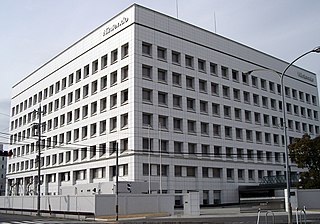
Doordarshan is an autonomous public service broadcaster founded by the Government of India, owned by the Broadcasting Ministry of India and one of Prasar Bharati's two divisions. One of India's largest broadcasting organisations in studio and transmitter infrastructure, it was established on 15 September 1959. Doordarshan, which also broadcasts on digital terrestrial transmitters, provides television, radio, online and mobile service throughout metropolitan and regional India and overseas through the Indian Network and Radio India.
AlaskaOne was a Public Broadcasting Service (PBS) member network of public television stations based in Fairbanks, Alaska from 1995 to 2012. It served communities in Alaska outside Anchorage. It was operated by the University of Alaska Fairbanks.
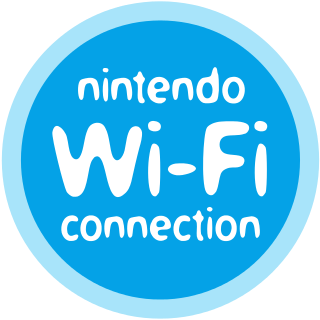
Nintendo Wi-Fi Connection was an online multiplayer gaming service run by Nintendo to provide free online play in compatible Nintendo DS and Wii games. The service included the company's Wii Shop Channel and DSi Shop game download services. It also ran features for the Wii and Nintendo DS systems.
Nintendo European Research & Development, formerly known as Mobiclip and Actimagine, is a Nintendo subsidiary, located in Paris, which develops software technologies and middleware for Nintendo platforms.
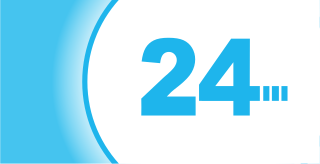
WiiConnect24 was a feature of the Nintendo Wi-Fi Connection for the Wii console. It was first announced at Electronic Entertainment Expo (E3) in mid-2006 by Nintendo. It enabled the user to remain connected to the Internet while the console was on standby. For example, a friend could send messages to another player's town without the other player being present in the game Animal Crossing: City Folk.
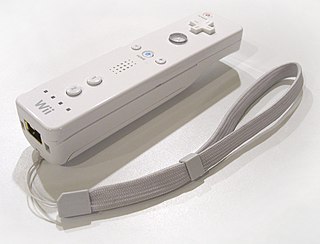
The Wii Remote, also known colloquially as the Wiimote, is the primary game controller for Nintendo's Wii home video game console. An essential capability of the Wii Remote is its motion sensing capability, which allows the user to interact with and manipulate items on screen via gesture recognition and pointing, using accelerometer and optical sensor technology. It is expandable by adding attachments. The attachment bundled with the Wii console is the Nunchuk, which complements the Wii Remote by providing functions similar to those in gamepad controllers. Some other attachments include the Classic Controller, Wii Zapper, and the Wii Wheel, originally used for the Mario Kart Wii racing video game.

The Utah Education Network (UEN) is a broadband and digital broadcast network serving public education, higher education, applied technology campuses, libraries, and public charter schools throughout the state of Utah. The Network facilitates interactive video conferencing, provides instructional support services, and operates a public television station (KUEN) on behalf of the Utah State Board of Regents. UEN services benefit more than 60,000 faculty and staff, and more than 780,000 students from pre-schoolers in Head Start programs through grandparents in graduate school. UEN headquarters are in Salt Lake City at the Eccles Broadcast Center on the University of Utah campus.
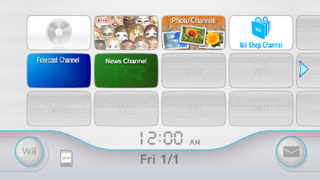
The Wii Menu is the graphical shell of the Wii game console, as part of the Wii system software. It has four pages, each with a 4:3 grid, and each displaying the current time and date. Available applications, known as "channels", are displayed and can be navigated using the pointer capability of the Wii Remote. The grid is customizable; users can move channels amongst the menu's 47 customizable slots by pressing and holding the A and B button while hovering over the channel the user wants to move. By pressing the plus and minus buttons on the Wii Remote users can scroll across accessing empty slots.

The Wii Shop Channel was an online shop for the Wii video game console that allowed users to download Virtual Console games, WiiWare games, and additional channels. The channel launched on December 10, 2006, and ceased operations on January 30, 2019. Available software was organized into three sections: Virtual Console, WiiWare, and Wii Channels. It is no longer possible to purchase content on the channel, but all previously purchased content can be redownloaded indefinitely as of February 2019. Upon its discontinuation, most software was removed from the channel, and the shop's interface reverted to its original 2006 design.
Nintendo System Development Division, commonly abbreviated as Nintendo SDD, was formerly known as Nintendo Network Business & Development, Nintendo Network Service Development, and Nintendo Special Planning & Development, was located in the Nintendo Research Institute in Kyoto, Japan, until it moved to the Nintendo Development Center, also in Kyoto. The division consisted of a single development team that focused on software and peripheral development. SDD was composed of two development departments with different duties: the Network Development & Operations Department, which handled Nintendo Network service programming, in cooperation with Nintendo Network Service Database, and the Environment Development Department, which developed Software Development Kits (SDKs), among other technologies.
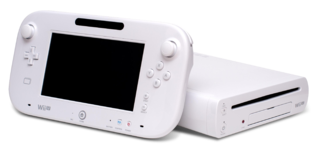
The Wii U is a home video game console developed by Nintendo as the successor to the Wii. Released in November 2012, it was the first eighth-generation video game console and competed with Microsoft's Xbox One and Sony's PlayStation 4.
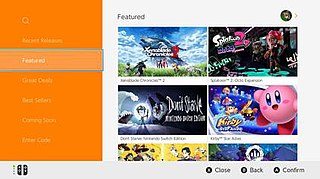
The Nintendo eShop is a digital distribution service powered by the Nintendo Network for the Nintendo 3DS, Wii U, and Nintendo Switch and by a dedicated online infrastructure for the Nintendo Switch. Launched in June 2011 on the Nintendo 3DS, the eShop was enabled by the release of a system update that added the functionality to the Nintendo 3DS's HOME Menu. It is the successor to both the Wii Shop Channel and DSi Shop. Unlike on the Nintendo 3DS, the eShop was made available on the launch date of the Wii U, although a system update is required in order to access it. It is also a multitasking application, which means it is easily accessible even when a game is already running in the background through the system software, though this feature is exclusive to the Wii U and the Nintendo Switch. The Nintendo eShop features downloadable games, demos, applications, streaming videos, consumer rating feedback, and other information on upcoming game releases.
Online console gaming involves connecting a console to a network over the Internet for services. Through this connection, it provides users the ability to play games with other users online, in addition to other online services.
Since its launch, sales of the Wii video game console had generally been higher than its competitors around the globe. According to the NPD Group, the Wii sold more units in the United States than the Xbox 360 and PlayStation 3 combined in the first half of 2007. This lead is even larger in the Japanese market, where it currently leads in total sales. In Australia the Wii broke the record set by the Xbox 360 and became the fastest-selling game console in Australian history.

The Nintendo Switch is a video game console developed by Nintendo and released on March 3, 2017. It is a hybrid console that can be used as both a stationary and portable device. Its wireless Joy-Con controllers, which include standard buttons and directional analog sticks for user input, motion sensing, and high-definition tactile feedback, can attach to both sides of the console to support handheld-style play. They can also connect to a Grip accessory to provide a traditional home console gamepad form, or be used individually in the hand like the Wii Remote and Nunchuk, supporting local multiplayer modes. The Nintendo Switch's software supports online gaming through standard Internet connectivity, as well as local wireless ad hoc connectivity with other Switch consoles. Nintendo Switch games and software are available on both physical flash-based ROM cartridges and digital distribution via Nintendo eShop; the system does not use region locking. As an eighth-generation console, the Nintendo Switch competes with Microsoft's Xbox One and Sony's PlayStation 4.
